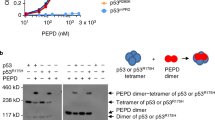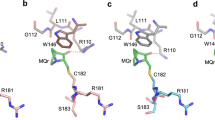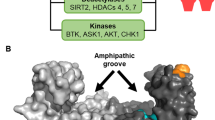Abstract
The functional diversity of the tumor suppressor protein p53 is mainly regulated by protein interactions. In this study, we describe a new interaction with the peptidyl-prolyl cis/trans isomerase cyclophilin 18 (Cyp18). The interaction reduced the sequence-specific DNA binding of p53 in vitro, whereas the inhibition of the interaction increased p53-reporter gene activity in vivo. The active site of the folding helper enzyme Cyp18 was directly involved in binding. The proline-rich region (amino acids 64–91) of p53 was most likely responsible for the observed binding because a synthetic peptide comprising amino acids 68–81 of p53 inhibited this interaction, and a p53 variant containing a proline residue at position 72 (p53P72) interacted with Cyp18 more effectively than the corresponding p53R72 variant. Impairment of the Cyp18–p53 interaction induced an accumulation of cells in the G2/M phase of the cell cycle, which was more pronounced when p53P72 was expressed compared with p53R72 in an otherwise isogenic cellular background. Moreover, p53-dependent apoptosis was elevated in Cyp18 knockout cells, suggesting an antiapoptotic potential of Cyp18–p53 complexes. Functional in vivo data hint to a possible clinical relevance of the p53–Cyp18 interaction observed.
This is a preview of subscription content, access via your institution
Access options
Subscribe to this journal
Receive 50 print issues and online access
$259.00 per year
only $5.18 per issue
Buy this article
- Purchase on Springer Link
- Instant access to full article PDF
Prices may be subject to local taxes which are calculated during checkout







Similar content being viewed by others
References
Akakura S, Yoshida M, Yoneda Y, Horinouchi S . (2001). A role for Hsc70 in regulating nucleocytoplasmic transport of a temperature-sensitive p53 (p53Val-135). J Biol Chem 276: 14649–14657.
Albrechtsen N, Dornreiter I, Grosse F, Kim E, Wiesmüller L, Deppert W . (1999). Maintenance of genomic integrity by p53: complementary roles for activated and non-activated p53. Oncogene 18: 7706–7717.
Arévalo-Rodríguez M, Cardenas ME, Wu X, Hanes SD, Heitman J . (2000). Cyclophilin A and Ess1 interact with and regulate silencing by the Sin3-Rpd3 histone deacetylase. EMBO J 19: 3739–3749.
Bauerschmidt C, Pollok S, Kremmer E, Nasheuer HP, Grosse F . (2007). Interactions of human Cdc45 with the Mcm2-7 complex, the GINS complex, and DNA polymerases delta and epsilon during S phase. Genes Cells 12: 745–758.
Bergamaschi D, Samuels Y, Sullivan A, Zvelebil M, Breyssens H, Bisso A et al. (2006). iASPP preferentially binds p53 proline-rich region and modulates apoptotic function of codon 72-polymorphic p53. Nat Genet 38: 1133–1141.
Braaten D, Luban J . (2001). Cyclophilin A regulates HIV-1 infectivity, as demonstrated by gene targeting in human T cells. EMBO J 20: 1300–1309.
Choi KJ, Piao YJ, Lim MJ, Kim JH, Ha J, Choe W et al. (2007). Overexpressed cyclophilin A in cancer cells renders resistance to hypoxia- and cisplatin-induced cell death. Cancer Res 67: 3654–3662.
Dumont P, Leu JI, Della Pietra ACr, George DL, Murphy M . (2003). The codon 72 polymorphic variants of p53 have markedly different apoptotic potential. Nat Genet 33: 357–365.
Fanghänel J . (2003). Enzymatic catalysis of the peptidyl-prolyl bond rotation: are transition state formation and enzyme dynamics directly linked? Angew Chem Int Ed Engl 42: 490–492.
Fischer G, Bang H, Mech C . (1984). Determination of enzymatic catalysis for the cis-trans-isomerization of peptide binding in proline-containing peptides. Biomed Biochim Acta 43: 1101–1111.
Fischer G, Wittmann-Liebold B, Lang K, Kiefhaber T, Schmid FX . (1989). Cyclophilin and peptidyl-prolyl cis-trans isomerase are probably identical proteins. Nature 337: 476–478.
Fujimori F, Takahashi K, Uchida C, Uchida T . (1999). Mice lacking Pin1 develop normally, but are defective in entering cell cycle from G(0) arrest. Biochem Biophys Res Comm 265: 658–663.
Gamble TR, Vajdos FF, Yoo S, Worthylake DK, Houseweart M, Sundquist WI et al. (1996). Crystal structure of human cyclophilin A bound to the amino-terminal domain of HIV-1 capsid. Cell 87: 1285–1294.
Harding MW, Handschumacher RE, Speicher DW . (1986). Isolation and amino acid sequence of cyclophilin. J Biol Chem 261: 8547–8555.
Harrison RK, Stein RL . (1990). Mechanistic studies of peptidyl prolyl cis-trans isomerase: evidence for catalysis by distortion. Biochemistry 29: 1684–1689.
Herman M, Weinstein T, Korzets A, Chagnac A, Ori Y, Zevin D et al. (2001). Effect of cyclosporin A on DNA repair and cancer incidence in kidney transplant recipients. J Lab Clin Med 137: 14–20.
Howard BA, Furumai R, Campa MJ, Rabbani ZN, Vujaskovic Z, Wang XF et al. (2005). Stable RNA interference-mediated suppression of cyclophilin A diminishes non-small-cell lung tumor growth in vivo. Cancer Res 65: 8853–8860.
Howard BA, Zheng Z, Campa MJ, Wang MZ, Sharma A, Haura E et al. (2004). Translating biomarkers into clinical practice: prognostic implications of cyclophilin A and macrophage migratory inhibitory factor identified from protein expression profiles in non-small cell lung cancer. Lung Cancer 46: 313–323.
Hsu T, McRackan D, Vincent TS, Gert de Couet H . (2001). Drosophila Pin1 prolyl isomerase Dodo is a MAP kinase signal responder during oogenesis. Nature Cell Biol 3: 538–543.
Jensen P, Hansen S, Møller B, Leivestad T, Pfeffer P, Geiran O et al. (1999). Skin cancer in kidney and heart transplant recipients and different long-term immunosuppressive therapy regimens. J Am Acad Dermatol 40: 177–186.
Johnson MD, Kinoshita Y, Xiang H, Ghatan S, Morrison RS . (1999). Contribution of p53-dependent caspase activation to neuronal cell death declines with neuronal maturation. J Neurosci 19: 2996–3006.
King FW, Wawrzynow A, Hohfeld J, Zylicz M . (2001). Co-chaperones Bag-1, Hop and Hsp40 regulate Hsc70 and Hsp90 interactions with wild-type or mutant p53. EMBO J 20: 6297–6305.
Lamb P, Crawford L . (1986). Characterization of the human p53 gene. Mol Cell Biol 6: 1379–1385.
Laptenko O, Prives C . (2006). Transcriptional regulation by p53: one protein, many possibilities. Cell Death Differ 13: 951–961.
Larsson R, Bergh J, Nygren P . (1991). Combination of cyclosporin A and buthionine sulfoximine (BSO) as a pharmacological strategy for circumvention of multidrug resistance in small cell lung cancer cell lines selected for resistance to doxorubicin. Anticancer Res 11: 455–459.
Liou YC, Ryo A, Huang HK, Lu PJ, Bronson R, Fujimori F et al. (2002). Loss of Pin1 function in the mouse causes phenotypes resembling cyclin D1-null phenotypes. Proc Natl Acad Sci USA 99: 1335–1340.
Liu W, Youn HD, Zhou XZ, Lu KP, Liu JO . (2001). Binding and regulation of the transcription factor NFAT by the peptidyl prolyl cis-trans isomerase Pin1. FEBS Lett 496: 105–108.
Ma L, Wagner J, Rice JJ, Hu W, Levine AJ, Stolovitzky GA . (2005). A plausible model for the digital response of p53 to DNA damage. Proc Natl Acad Sci USA 102: 14266–14271.
Marks WH, Harding MW, Handschumacher R, Marks C, Lorber MI . (1991). The immunochemical distribution of cyclophilin in normal mammalian tissues. Transplantation 52: 340–345.
Matlashewski GJ, Tuck S, Pim D, Lamb P, Schneider J, Crawford LV . (1987). Primary structure polymorphism at amino acid residue 72 of human p53. Mol Cell Biol 7: 961–963.
Pinton P, Rimessi A, Marchi S, Orsini F, Migliaccio E, Giorgio M et al. (2007). Protein kinase C beta and prolyl isomerase 1 regulate mitochondrial effects of the life-span determinant p66Shc. Science 315: 659–663.
Price ER, Jin M, Lim D, Pati S, Walsh CT, McKeon FD . (1994). Cyclophilin B trafficking through the secretory pathway is altered by binding of cyclosporin A. Proc Natl Acad Sci USA 91: 3931–3935.
Pyrzynska B, Serrano M, Martinez AC, Kaminska B . (2002). Tumor suppressor p53 mediates apoptotic cell death triggered by cyclosporin A. J Biol Chem 277: 14102–14108.
Rey O, Baluda MA, Park NH . (1999). Differential gene expression in neoplastic and human papillomavirus-immortalized oral keratinocytes. Oncogene 18: 827–831.
Rippmann JF, Hobbie S, Daiber C, Guilliard B, Bauer M, Birk J et al. (2000). Phosphorylation-dependent proline isomerization catalyzed by Pin1 is essential for tumor cell survival and entry into mitosis. Cell Growth Differ 11: 409–416.
Ross HJ, Cho J, Osann K, Wong SF, Ramsinghani N, Williams J et al. (1997). Phase I/II trial of low dose cyclosporin A with EP for advanced non-small cell lung cancer. Lung Cancer 18: 189–198.
Scheibel T, Buchner J . (1998). The Hsp90 complex--a super-chaperone machine as a novel drug target. Biochem Pharmacol 56: 675–682.
Shevchenko A, Wilm M, Vorm O, Mann M . (1996). Mass spectrometric sequencing of proteins silver-stained polyacrylamide gels. Anal Chem 68: 850–858.
Siddique M, Sabapathy K . (2006). Trp53-dependent DNA-repair is affected by the codon 72 polymorphism. Oncogene 25: 3489–3500.
Soe K, Hartmann H, Schlott B, Stevnsner T, Grosse F . (2002). The tumor suppressor protein p53 stimulates the formation of the human topoisomerase I double cleavage complex in vitro. Oncogene 21: 6614–6623.
Taylor WR, DePrimo SE, Agarwal A, Agarwal ML, Schonthal AH, Katula KS et al. (1999). Mechanisms of G2 arrest in response to overexpression of p53. Mol Biol Cell 10: 3607–3622.
Thomas M, Kalita A, Labrecque S, Pim D, Banks L, Matlashewski G . (1999). Two polymorphic variants of wild-type p53 differ biochemically and biologically. Mol Cell Biol 19: 1092–1100.
Vogelstein B, Lane D, Levine AJ . (2000). Surfing the p53 network. Nature 408: 307–310.
Vousden KH, Lane DP . (2007). p53 in health and disease. Nat Rev Mol Cell Biol 8: 275–283.
Whitesell L, Sutphin PD, Pulcini EJ, Martinez JD, Cook PH . (1998). The physical association of multiple molecular chaperone proteins with mutant p53 is altered by geldanamycin, an hsp90-binding agent. Mol Cell Biol 18: 1517–1524.
Wulf G, Ryo A, Liou YC, Lu KP . (2003). The prolyl isomerase Pin1 in breast development and cancer. Breast Cancer Res 5: 76–82.
Wulf GM, Liou YC, Ryo A, Lee SW, Lu KP . (2002). The prolyl isomerase Pin1 in breast development and cancer. J Biol Chem 277: 47976–47979.
Yaffe MB, Schutkowski M, Shen M, Zhou XZ, Stukenberg PT, Rahfeld JU et al. (1997). Sequence-specific and phosphorylation-dependent proline isomerization: a potential mitotic regulatory mechanism. Science 278: 1957–1960.
Yang WM, Inouye CJ, Seto E . (1995). Cyclophilin A and FKBP12 interact with YY1 and alter its transcriptional activity. J Biol Chem 270: 15187–15193.
Zacchi P, Gostissa M, Uchida T, Salvagno C, Avolio F, Volinia S et al. (2002). The prolyl isomerase Pin1 reveals a mechanism to control p53 functions after genotoxic insults. Nature 419: 853–857.
Zheng H, You H, Zhou XZ, Murray SA, Uchida T, Wulf G et al. (2002). The prolyl isomerase Pin1 is a regulator of p53 in genotoxic response. Nature 419: 849–853.
Zylicz M, King FW, Wawrzynow A . (2001). Hsp70 interactions with the p53 tumour suppressor protein. EMBO J 20: 4634–4638.
Acknowledgements
This work was supported by the Deutsche Forschungsgemeinschaft grant GK1026 (to CS-F) and SFB604 (to Gunter Fischer, Halle, and FG). The technical assistance of Mrs Anita Willitzer is acknowledged. Jurkat cells were kindly provided by J Luban (Columbia University, New York).
Author information
Authors and Affiliations
Corresponding author
Additional information
Supplementary Information accompanies the paper on the Oncogene website (http://www.nature.com/onc)
Supplementary information
Rights and permissions
About this article
Cite this article
Baum, N., Schiene-Fischer, C., Frost, M. et al. The prolyl cis/trans isomerase cyclophilin 18 interacts with the tumor suppressor p53 and modifies its functions in cell cycle regulation and apoptosis. Oncogene 28, 3915–3925 (2009). https://doi.org/10.1038/onc.2009.248
Received:
Revised:
Accepted:
Published:
Issue Date:
DOI: https://doi.org/10.1038/onc.2009.248
Keywords
This article is cited by
-
p53-mediated AKT and mTOR inhibition requires RFX7 and DDIT4 and depends on nutrient abundance
Oncogene (2022)
-
Purification and characterization of Cyclophilin: a protein associated with protein folding in Salmonella Typhimurium
Archives of Microbiology (2021)
-
Cell cycle shift from G0/G1 to S and G2/M phases is responsible for increased adhesion of calcium oxalate crystals on repairing renal tubular cells at injured site
Cell Death Discovery (2018)
-
Selective targeting p53WT lung cancer cells harboring homozygous p53 Arg72 by an inhibitor of CypA
Oncogene (2017)
-
Modelling the molecular mechanism of protein–protein interactions and their inhibition: CypD–p53 case study
Molecular Diversity (2015)



